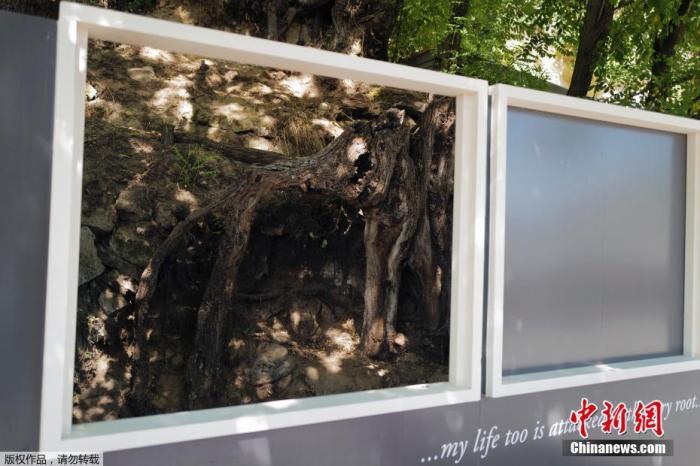China News Agency, Auvé-sur-Oise, France, July 30th. Title: 130th Anniversary of Van Gogh’s Death: Visiting the resting place of the world-renowned master painters
China News Agency reporter Li Yang
On the 130th anniversary of the death of the world-renowned Dutch painter Vincent Van Gogh, China News Agency reporters visited the place where Van Gogh was resting, the small town of Auvers-Sur-Oise in northern France.
Compared with the era when Van Gogh lived 130 years ago, the scenery of this simple and quiet town has not changed much. A street runs from east to west, and the main buildings are distributed on both sides of the street. To the north of the town are still large wheat fields and corn fields. Many people from Paris choose to take the train, and only local trains stop here.
The picture shows Van Gogh's resting place, taken on July 29, local time, where he was buried with his brother Theo Van Gogh. There is a cluster of sunflowers in full bloom in front of the two cemeteries, which are particularly eye-catching. Photo by China News Agency reporter Li Yang
Van Gogh spent the last few months of his life in this small town. The church, city hall, farmland and other scenery here were all painted by Van Gogh in his final works, leaving Van Gogh everywhere. Footprint. It is not too much to describe here as the "City of Van Gogh".
The location of Van Gogh's tomb in the local cemetery is unremarkable. He was buried with his brother Theo Van Gogh. There is a cluster of sunflowers in full bloom in front of the two cemeteries, which are particularly eye-catching. The tomb of Van Gogh is extremely frugal. The small tombstone is engraved with "Ici Repose Vencent Van Gogh" (Ici Repose Vencent Van Gogh) and his birth and death year "1853-1890".
Van Gogh died on July 29, 1890, and was buried here on July 30. There have been different opinions about the cause of Van Gogh's death. Since there were no witnesses at the time, the shooting that led to his death is still confusing. Many biographies of Van Gogh still attribute it to suicide when they write about the cause of Van Gogh's death.
Wouter van der Veen, a scholar who studied the life of Van Gogh, announced this week that he had discovered the exact location of the last oil painting "Roots" created by Van Gogh before he died from a gunshot wound. The painting shows brightly colored tree trunks, roots and stumps, and the relevant locations should be located in small towns. Experts from the Van Gogh Museum in the Netherlands also expressed support for this discovery.
During France's "closed city" due to the new crown pneumonia epidemic, Van der Wen spent his free time at home sorting out Van Gogh-related documents and found inspiration through an old local postcard.
The creation site of Vincent Van Gogh's last work "Tree Roots" is protected by isolation devices.
Someone pointed out that Van Gogh was engaged in painting almost every day and should not commit suicide, especially since he was still working on "Roots" before the shooting. However, Van der Wen believes that Van Gogh's painting shows "the theme of life and death" and is "a kind of farewell."
The revolver believed to be used by Van Gogh to commit suicide was sold at an auction in Paris last year for 162,500 Euros. It is known as the "most famous weapon in art history." A rusty 7mm bullet is on display in the Van Gogh Museum in the Netherlands.
As signs of a rebound from the new crown pneumonia epidemic in France are becoming more apparent, the number of confirmed patients is increasing again, and the number of people visiting Van Gogh's resting place is also drastically reduced. The reporter noticed that on the anniversary of Van Gogh’s death, commemorative activities were supposed to be held, but now there are only a few visitors, and most of them are from France, and related commemorative activities have not been held. This may be a good thing for the protection of Van Gogh’s tomb. It is said that it can only accept 10,000 visitors each year, while the actual number of visitors before the epidemic was tens of thousands.
The Auberge Ravoux in the small town was the place where Van Gogh last lived and died, and it has largely maintained the style of the Van Gogh era. Also due to the epidemic, Lawu Inn has not resumed its opening to the outside world. The Lawu Inn’s announcement stated that the inn will also be closed for the rest of this year. For Van Gogh fans visiting the local area, this is a pity.
Outside the tomb of Van Gogh, is a large wheat field. Van Gogh created the oil painting "Crows on the Wheat Field" here in July 1890. A big sign marked the specific location of Van Gogh's creation. 130 years later, the scene in reality and the presentation on the oil painting are still almost the same, or it can be regarded as a tribute to this great painter.
"Crows on the Rye" is considered to be "one of the most powerful and controversial paintings" by Van Gogh, and has been interpreted by professionals. The painter was troubled by mental illness at the time, so this painting carried his mood at that time. People can feel the artist's mental state in the wheat field.
Now, the vast wheat fields seem to extend to the sky, and several young girls are taking pictures in the wheat fields; several French people walk through the fields on foot, searching for Van Gogh's marks. Although Van Gogh has passed away for more than a century, his depiction of real life is still in people's hearts. Even during the epidemic, people's lives continue to move forward. (Finish)

